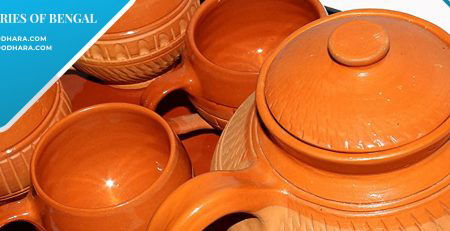The Enchanting Claydolls Of Krishnanagar
The craft that arises out of West Bengal is renowned all over the world, mainly because of its rustic charm. In fact the generationally passed down traditional crafts of West Bengal have moulded themselves so well according to the current day demands. It appears that these artisans, apart from their traditional skills, also hold expertise in the art of survival. Even with little understanding of arts and crafts, the unique handicrafts of West Bengal still manages to captivate.
Among all the state’s crafts, clay doll-making is amongst the most popular ones. These beautiful, lively clay structures are adorned with vibrant colours. They are endowed with animated, realistic depictions that speak for themselves. Rich colours and intricate details capture the tiniest fraction of reality into clay modelling. This dedication to specifics in each miniature clay doll makes them exclusive and embodies the very spirit of nature and life itself in their art form.
Historical records suggest that this craft rose under the patronage of then king – Maharaja Krishna Chandra Ray during 1710-83 AD. He was an ardent follower of fine arts, literature, and music and known to support artisans in continuous improvements of their trades benevolently. During his reign, the arts prospered brilliantly, capturing the attention of even the colonial British rulers! From Hindu deities to creating miniature clay dolls of real-life village people, inspiration came from numerous subjects from nature’s flora and fauna. This exceptional calibre also drew recognition on international shores.
True to its origins today, the clay art in Ghurni is practised as royal traditions at Krishnanagar Raj Bari.
Every year, the stunning idol of “Raj Rajeswari” (Devi Durga as worshipped by the royal family) is created by the local artists and placed for the sarbojonin puja at the palace grounds.
As part of the celebrations, the royal family marks an age-old tradition called “Shatru Badh (eliminating the enemy)”. According to the ritual, the king takes up a bow and shoots at a clay model tinged crafted from the artists’ hands, eliminating the evil forces.
Present Day Challenges
 As beautiful as the artworks are, craftspeople have been undergoing a financial crisis ever since the royal patronage waned to support them in their livelihood. Simultaneously, growing competition from cheap, machine-made reproductions of their superior hand-made products and lack of support at the government levels for long years have stifled the making of this art.
As beautiful as the artworks are, craftspeople have been undergoing a financial crisis ever since the royal patronage waned to support them in their livelihood. Simultaneously, growing competition from cheap, machine-made reproductions of their superior hand-made products and lack of support at the government levels for long years have stifled the making of this art.
Many artists are forced to forego their generations of talent and practice in this art form to support their families. Or, they are choosing to diversify with giant, larger-than-life-sized clay sculptures to meet the demands of current business trends over painstakingly creating the beautiful miniature (2”-3”) clay dolls. However, in the last few years, things are starting to look up again. With Government recognitions, awards, and initiatives by actively involved NGOs, the artisans are slowly reviving the art.
Where can we find this art today?
As a result, Krishnanagar clay dolls now have a newfound life as home décor items and accent pieces in homes or even themed restaurants and coffee shops. The clay dolls are made according to the following themes :
Religious Personalities like: Mother Mary, Mother Teresa, Jesus, Sai Baba, Lord Buddha, Mahaprabhu Chaitanya Deb etc.
Ramayana, Ved, Mahabharat, Characters like: Krishna, Arjun, Ram, Sita, Siva Parvati
Everyday Life Personalities: Fisherman, farmer, tribal couple, school teacher, brahmin
Cartoon: Doraemon, Chhota Bheem
Fruits and Vegetables, among many others
More efforts need to be directed towards equipping the artisans with modern tools, techniques, and technologies and acquainting them with new marketing methods to keep up with the business part of their trade in today’s tech-savvy world.
Hopefully, with these steps in place, it will revive Krishnanagar’s clay art in the near future because it’s truly an art worth preserving.












Leave a Reply
You must be logged in to post a comment.